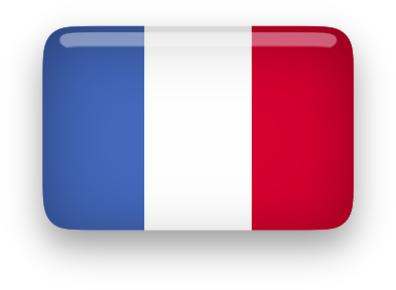


2023
Jan
Feb
Mar
Apr
May
Jun
Fougères - Sept
2022
Jan
Feb
Mar
Apr
May
Jun
Jul
Aug
Sep
Oct
Nov
Dec
2021
Jan
Feb
Mar
Apr
May
Jun
Jul
Aug
Sep
Oct
Nov
Dec
2020
Jan
Feb
Mar
Apr
May
Jun
Jul
Aug
Sep
Oct
Nov
Dec
2019
Jan
Feb
Mar
Apr
May
Jun
Jul
Aug
Sep
Oct
Nov
Dec
2018
Jan
Feb
Mar
Apr
May
Jun
Jul
Aug
Sep
Oct
Nov
Dec
2017
Jan
Feb
Mar
Apr
May
Jun
Jul
Aug
Sep
Oct
Nov
Dec
2016
Jan
Feb
Mar
Apr
May
Jun
Jul
Aug
Sep
Oct
Nov
Dec
2015
Aug
Sep
Oct
Nov
Dec
The most recent entries are at the top of this page. Earlier entries follow in reverse chronological order.

25.02.2017
Carnaval de Nice
Corso Illuminé (Night/Illuminated Parade)
The theme of the Nice Carnival this year is energy. The King and Queen floats were the Sun King and the Green Queen. We saw the daytime version of the Nice Carnival parade last year when the topic was media but this night time parade was by far the best we've seen - ever. It was massive, elaborate, frequently political, pretty and often funny. It was also expertly constructed, staged and executed. We loved it.
One float was of several French politicians including Sarcozy, Hollande, Fillon, Melenchon, Macron, Hammon, Le Pen, Bayrou and Vallis . The float had one of the male politicians trying to get up and a smiling Sarzocy lying down. Macron and Fillion stood outside a round hamster wheel that held Le Pen. These political figures were also marched through the crowds.
In addition to a very large number of amazing floats there were cheerleaders in flashy costumes leading the crowd, an MC in even flashier attire and many dancers and marchers in costume including polar bears, smoke stacks, oil barrels, nuclear power plants, oil slicked birds, people in radiation safety garb, eels, jellyfish with lights like lightning and mutated fish, humans and other animals.
There were dozens of dance groups including dancers who represented Brazil, some African countries, Thailand and many other nations. There were also a few sets of break dancers and there were some amazing stilt dancers and even some pogo stick dancers. One in particular was extremely skillful in his dancing and jumping high on his pogo stick legs.
And once again John was smitten with the flag throwers and the medieval marching bands.
There was one risqué float this year and last. This year it was a bare bottomed man sucking in air and then powering a fan behind him (presumably as he passed gas). Last year's was about a sex scandal of a French politician. Not the kind of things you'd find in mainstream "family friendly" floats in America.
In addition to the Trump floats in the Carnivals of Nice and Viareggio (which was issues-packed and well presented), the Dusseldorf Carnival (known as Rose Monday) presented a clever Trump float. See pics below.
As I mentioned above, the theme of the Nice Carnival this year is energy (last year it was media). Trump's float protests his change from the U.S. pursuing renewable energy to oil and for no longer allowing climate change research by federal employees. The green things around him are hair dryers for his weird hair and wasteful energy policies.
These are links to videos of this year's floats. Nice always has these type of floats during its Carnival.
Video of Parade
Video of Floats Being Constructed
Videos of Nice Night floats
Link
Link
This brochure was put out for the press for the Carnaval de Nice.
The Nice parade had many musicians: solo, drummers, ensembles and marching bands. Some of the audience members were dressed in colorful garb including hats, glow sticks, dresses and scarves in colors of the French flag. Many times we were covered with confetti and streamers from the mini confetti canons used to spray us.
We were far back in the bleachers, under-dressed (by midnight the temps were quite low) and too close to the fog machines and speakers. Next year we'll dress warmer and get batter seats. There were at least 6,000 people in the bleachers and many hundreds more on the ground level.
At the end when we tried to leave we were blocked by the police. We soon realized that the crowd had moved to where the entrance/exit had been earlier so they could watch the burning of the king. It wasn't the king used in the parade, it was a smaller and streamlined version of the king float. I think at the end of the Carnival, on the 25th of February, the large king float is burned. I'm not sure. This year the route was curtailed and the parade did not travel along the promenade near the water. Usually the burning takes place near the water like a Viking funeral. The route of the parade had been curtailed a lot for safety reasons but the parade was spectacular nonetheless.
I love Nice!
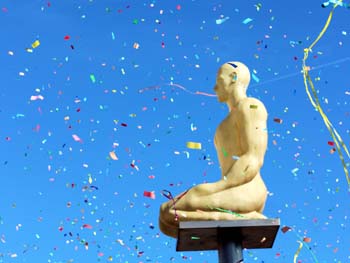
|
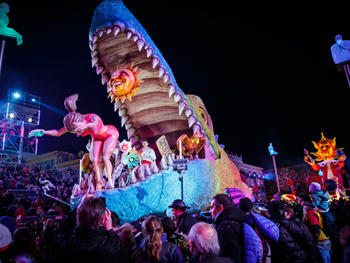
|
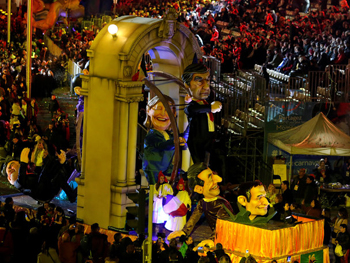
|
| Confetti and one of Jaume Plensa's statues in Massena Square | The floats had an energy theme this year. |
An energy hampster wheel powered by French politicians |
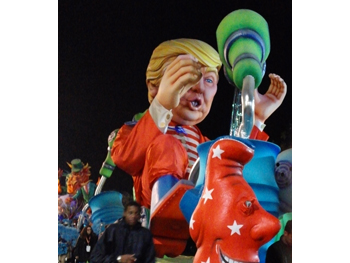
|
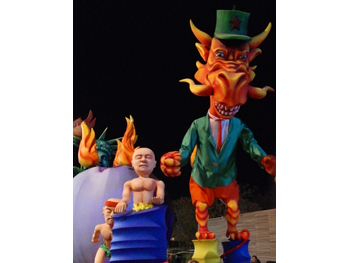
|
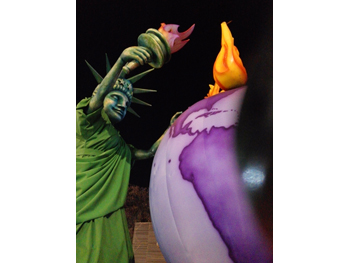
|
| Change of Wind float with Trump as king of oil consumption using hair dryers | The Fatal Feast float with the US and China consuming the world's resources | More of the Fatal Feast float |
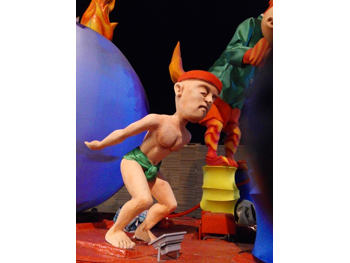
|
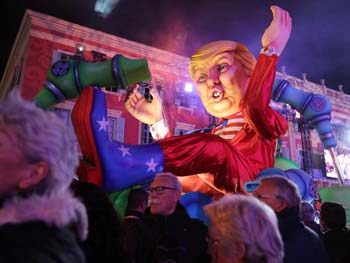
|
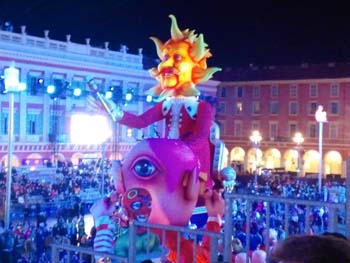
|
| A detail of the Fatal Feast float | Change of Wind Trump float again | The Sun King Renewable Energy float |
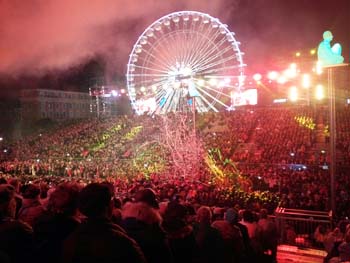
|
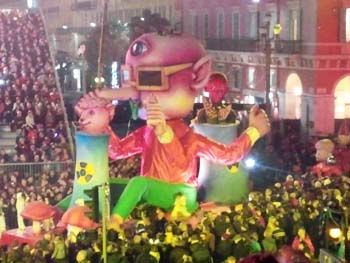
|
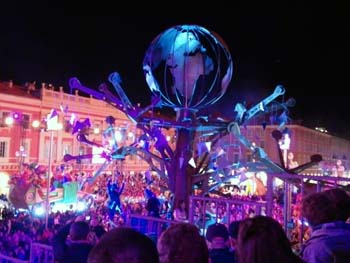
|
| Fog, lights, confetti and a ferris wheel | Nuclear energy causes genetic mutations float. What fun! | The Energy Tree float |
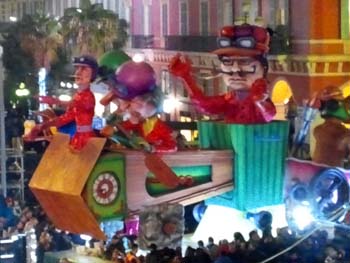
|
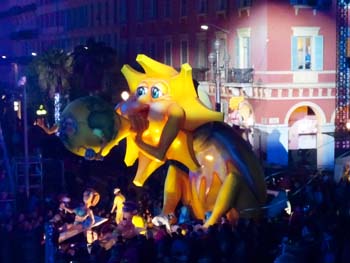
|
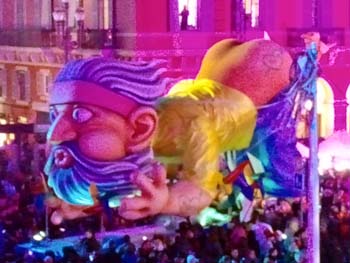
|
|
The Ecological Raft float dealing with hypocrisy and government |
Sea, sex and KWH float. Where the warm sunny climate of Nice could provide solar energy for France. | The "wind" is the future of man! Air from both ends powers windmills. |
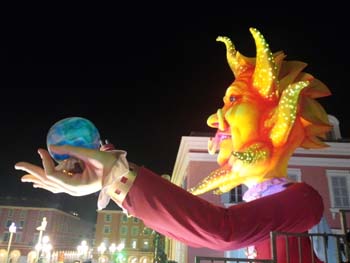
|
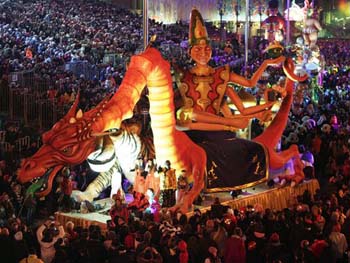
|
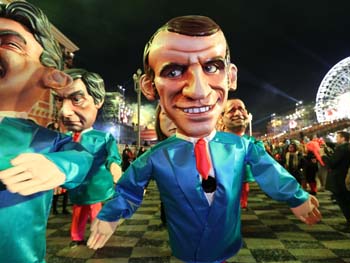
|
| The Sun King float | Asian themed energy float |
French presidential candidates are popular objects of scorn |
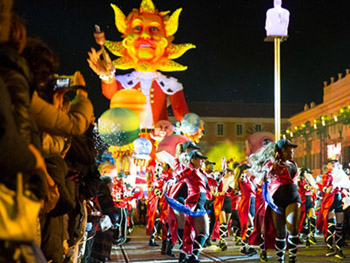
|
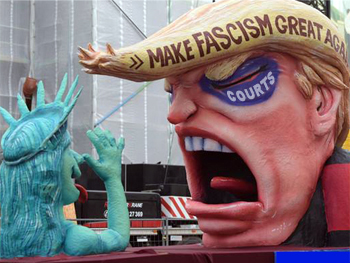
|
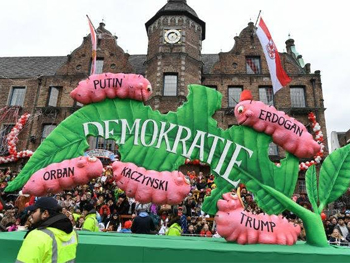
|
| Another view of the Sun King float |
Here's a Trump float from a Dusseldorf, Germany parade. |
Certain politicians eating away democracy from a Dusseldorf, Germany parade |

22.02.2017
Carnaval de Nice
Battle of Flowers (Bataille des fleurs)
This year we attended the "Battle of Flowers" parade (we missed it last year). John bought tickets so we could sit in the stands. We had a great view. There were many great individual giant puppets, dancers, stilt walkers, oversized helium balloons, and musicians. A variety of flowers were thrown to the crowds including nodosum geraniums (which look very different from the geraniums I'm used to), chicory, lillies, roses, lavender, alpine colombine, gladiolas, tokyos, gerberas, daisies, carnations - all of which are native to Provence. I went home with a large bouquet of yellow Mimosa tree flowers. There's a photo of them below. The ones in Texas are purple and others in the states are pink. There were several beautiful flower floats. Here is a short video of the flower parade and another that is longer with much more detail but there were many other characters which are not shown in either video such as the many stilt-walking characters, all of whom were fabulous: black dragons, colorful flaminco style dancers, big puffy walkers in bright pastel colors and more. There were also giant ballons including jelly fish, eels, the Stay-Pufft Marshmallow guy, and many others. We took a lot of photos.
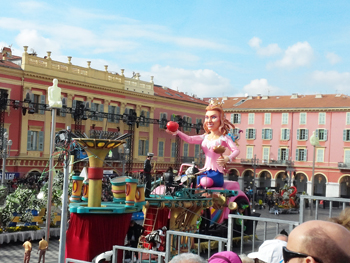
|
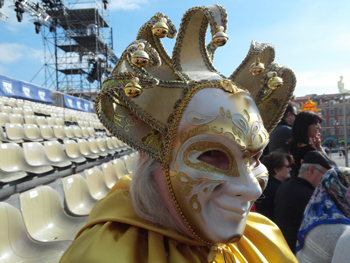
|
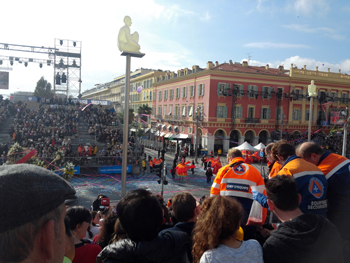
|
| Carnival Queen float |
Ruth is ready for the Carnival Battle of Flowers parade |
Paramedics help a woman down the stairs. |
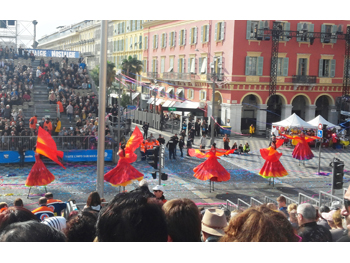
|
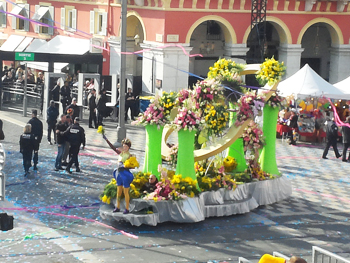
|
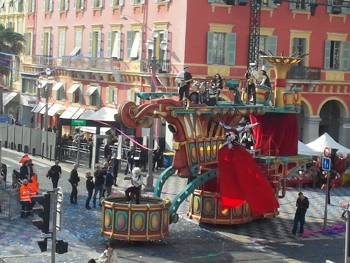
|
| Colorful dancers on stilts | Small flowers float | Large rock 'n roll float with live performers. |
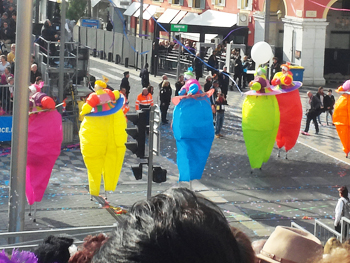
|
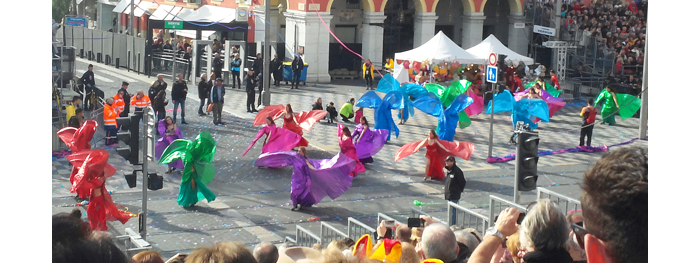
|
| Bubble dancers on stilts | The Flowers parade had many dancers |
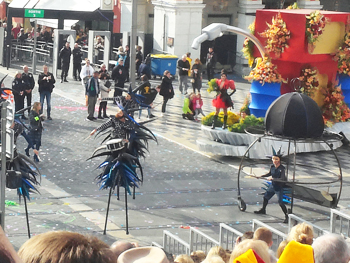
|
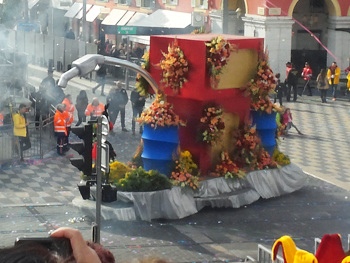
|
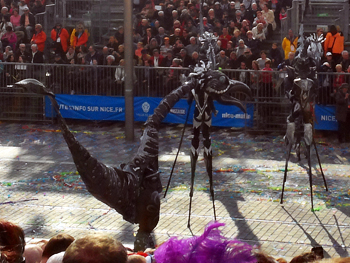
|
| More stilt dancers | Another flower float | Dinosaur raptors on stilts |
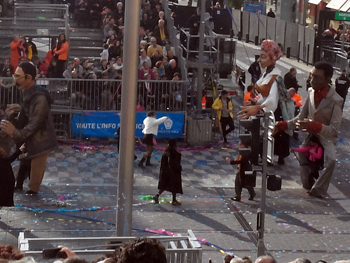
|
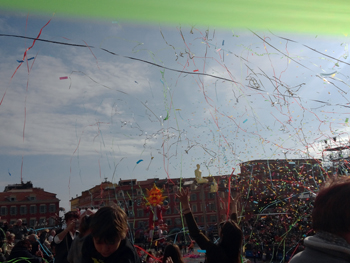
|
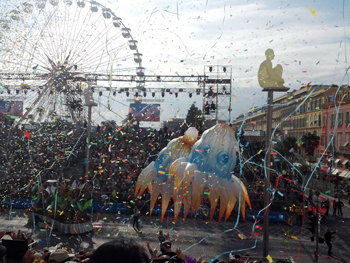
|
| Giant Cool Jazz puppets |
Lots of confetti cannons fired throughout the parade. |
Giant jellyfish balloons |
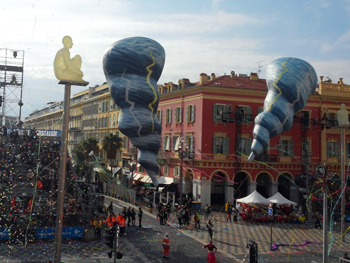
|
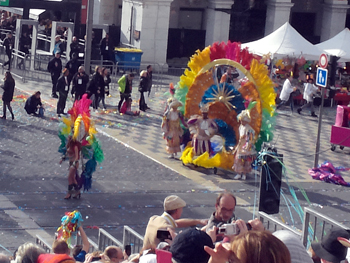
|
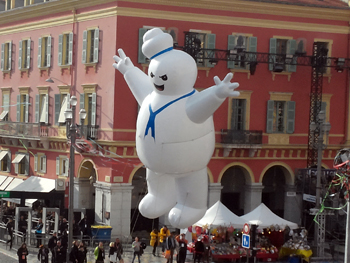
|
| Giant tornado balloons | Rio dancers | Stay Puft Marshmallow Man balloon |
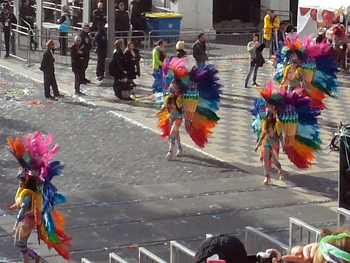
|
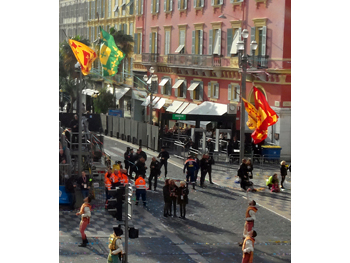
|
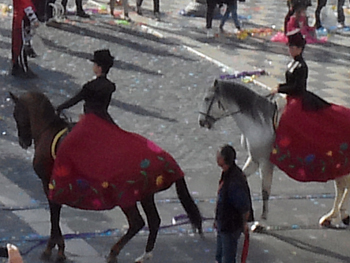
|
| More carnival dancers | Medieval flag throwers | Equestrian riders |
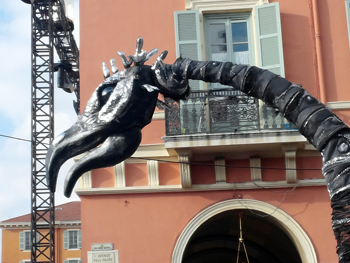
|
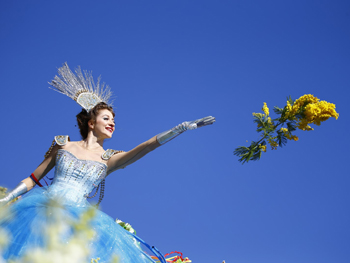
|
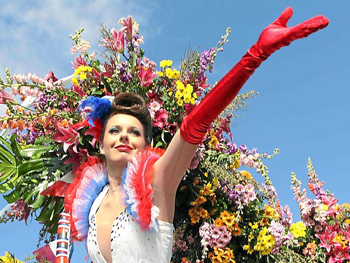
|
| Dinosaur raptor puppet | Throwing flowers to the crowds | One of the flower queens |
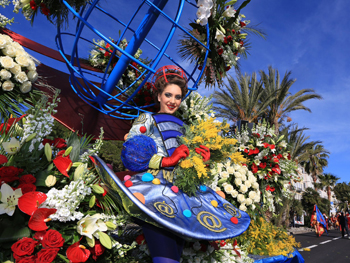
|
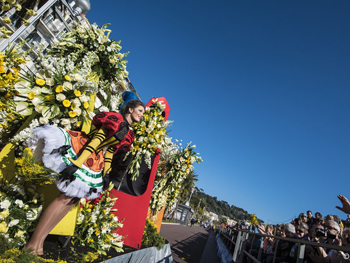
|
|
| Another flower queen |
The Battle of the Flowers parade is very popular in Nice |

Carnaval de Venice
17.02.2017 - 19.02.2017
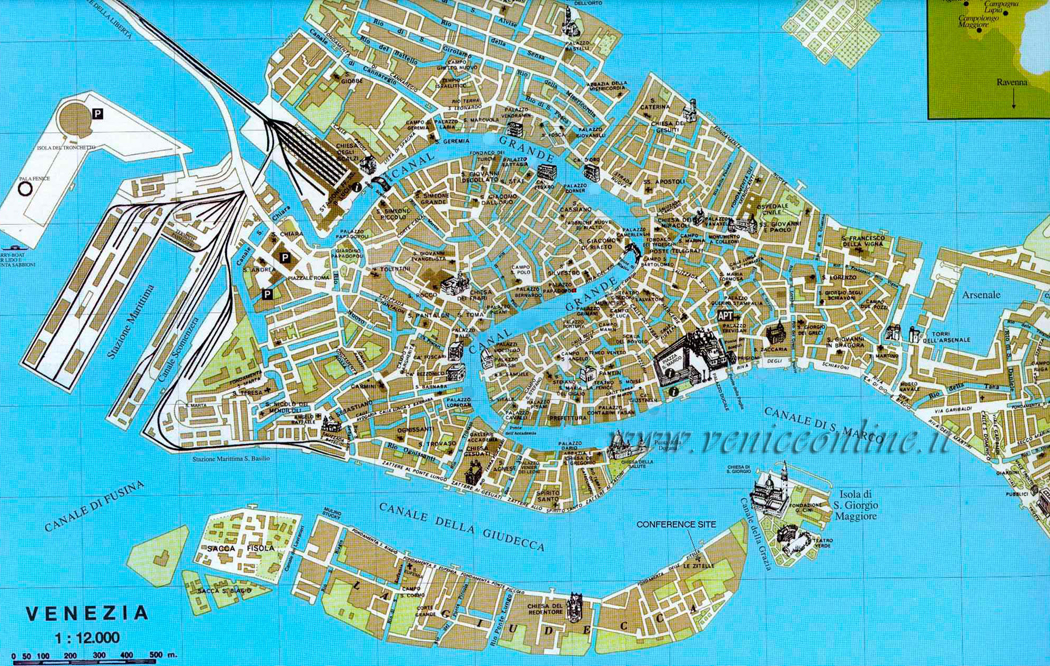
|
John's history lessons -- John researches our trips or he just knows a lot of history stuff because history and archaeology are his big time fascinations (along with Star Wars and other sci-fi stories). I should record John's stories because the way he tells them is just so very precious.
As John tells it, the Venetian forebearers fled to the swamps of the Venetian Lagoon to escape the barbarian invasions from the north and east during the fall of the Roman Empire. Eventually Venice grew as a trading community and became richer in doing so.
Venice was the first European republic and at that time there was a voice vote in San Marco square to select the leadership. Pretty much whoever was loudest won. John told me, if the people wanted Phil to win they would yell "Phil", "Phil!", "Phil", "Phil!!". If the majority of the people yelled "Phil", then Phil would be the new Doge.
The people began their trade with their plentiful fish. Later basins were flooded and blocked off. The sun evaporated the water leaving behind salt which was in high demand and was also traded. I'll leave to you to read about the progression of their trade, countries that ruled Venice and the relationshp between Venice and Constantinople (if you have an interest).
History of the city of Venice and why it is built on water
History of the Republic of Venice
Most Serene
" ‘Serenissimo’ was a Byzantine title, bestowed upon the Doge and the Signoria of Venice at first, then extended to the entire Republic of Venice. ‘Most Serene’ was an honorary appellate and an indicator of sovereignty. From the outside, Venice looked like a peaceful place, spared from the turmoil affecting so many other cities. The choice to focus on maritime trade brought prosperity, and the establishment of a liberal republic laid the foundation for a solid state, generally accepted by its citizens, who, no matter their class, seemed to get along well, united by the devotion for the territory they lived in. Even when dealing with foreign policy affairs, Venice often tried to avoid conflict and disputes, preferring mediation and peace. On these bases, Venice could well be described as ‘serene’, so much so that it was able to survive for three centuries its political, military and commercial decline, caused by Turkish expansion and the discovery of the Americas. Diplomacy, wealth, justice and prosperity, the main aspects of the history of Venice, have indeed made it ‘Serenissima’."
John and I have had fun over the years singing the Italian National Anthem. It goes like this:
"When the moon hits your eye like a big pizza pie
That's amore (that's amore).
When the world seems to shine like you've had too much wine
That's amore
Bells will ring ting-a-ling-a-ling, ting-a-ling-a-ling
And you'll sing "Vita bella"
Hearts will play tippy-tippy-tay, tippy-tippy-tay
Like a gay tarantella"
The song was first featured in the 1953 movie, "The Caddy", starring Dean Martin and Jerry Lewis. In his autobiography, Jerry Lewis states that when he and Dean Martin were making "The Caddy", the writers left Martin with very little to do for some time in the movie. Jerry Lewis, without Dean Martin's knowledge, asked songwriter Harry Warren to write a hit song for Dean to sing in the movie. "That's Amore" is that song. The song received a nomination for the "Academy Award for Best Original Song" that year. It was a just filler song that became an Academy Award nominated big hit. And we sing it to this day.
The tarantella is a Southern Italian folk dance accompanied by a tamborine. Video
When John would sing that last verse he would always say "gay tarantula" instead of gay tarantella. He was being goofy and it was cute BUT after doing research for our Venice trip John learned that the tarantella dance was a superstitious dance which was believed to rid people of the venom of the biting tarantulas. After a few iterations the name of the dance became the Tarantella.
So now John and I both sing "gay tarantula (dance)". (Big Smile) The tarantella is also popular in Argentina.
Basillica de Frai
While exploring the main island of Venice we visited the Basillica de Frai (Church) and admired the great art including Titian's Assumption of the Virgin. This was a biggie for John. John likes great art. I like a wide variety of art and the colors in religious art are lovely but early surrealistics are my favorites. So when we travel North we'll check out Magritte, Munch, Max Ernst, and back to Spain to Salvador Dali and Joan Miro and more art, history, science ...
Leonardo da Vinci Museum
The Leonardo da Vinci museum wasn't very big, but it has a lot of his inventions modeled in wood and iron including a helicopter, an armored tank, a calculator, use of concentrated solar power, double hulled boats, anatomy drawings and text on his theory of plate techtonic. In practice, he greatly advanced the state of knowledge in the fields of anatomy, astronomy, civil engineering, optics, and the study of water (hydrodynamics). Leonardo's most famous drawing, the Vitruvian Man, is a study of the proportions of the human body. The work links art and science and has come to represent Renaissance Humanism. Several pieces of original art and replicas of others were on diplay. Da Vinci spent most of his time in Florence so most of his work is there and some of his paintings, including the Mona Lisa, are in the Louvre in Paris.
The small museum in Venice contained a vast work of Leonaro's theories and prototypes and full scale models from many fields of science, put to paper. To see them first hand was a gift. If you'd like to explore more about Da Vinci's inventions visit the web page Top 10 Leonardo da Vinci Inventions.
Floats
I love floats. There were no moving floats in St. Mark's Square (that's just not right). We saw a few floats that were stationary. One was made of citrus fruit (oranges, lemons and grapefruits). There were floats elsewhere near the island and in other parts of Italy, and on the canals after we left. The was also the Angelo, the angel who flew from the sky, which was a big event. When I tried asking some Italians who spoke English if there were going to be any floats they said (excitedly) ah! Angelo! Angelo! It took me awhile to understand what an angel had to do with the floats. (a floating angel).
San Marco Basillica
From St Mark's Square we could clearly see the 15th Century clock tower of the Basillica San Marco. The displays of this clock are digital, and analog and has zodiac signs and unusual numbering.
The bell tower was built in 829. In 1902 the bell tower fell down and then in 1912 it was rebuilt exactly as it had been. From the balcony of the Basillica of San Marco we could also see the costumed crowds below. Here is a video of the first night of the Carvival and some images of masks, costumes and floats on the water.
Later we went through the first floor Treasury at the Basillica San Marco. See photos below. Lots of gold and jewels which were gorgeous but John liked best the geometric art of the tiles on the floors of the Basilica. He picked up several postcards. Upstairs we saw bronze horses (Triumphal Quadriga) and the statue "Portrait of the Four Tetrarchs" carved in 400 AD using stonework taken from raids on Constantinople. The ruling structure of the time was to have four rulers (Tetrarchs) which is represented by this sculpture. This sculpture and the history of the government makes for a fascinating read. You can find more information about the Triumphal Quadriga here and about the "Portrait of the Four Tetrarchs"here.
There is so much great history related to these statues. I recommend that you follow the two links above to better understand and experience the life and happenings of those times. John told me many of these stories and histories at the time we visited the buildings, other archetecture and sculptures. He is a great travel companion and tour guide.
Relics
The word relic has several meanings. Two of them are:
1) an object surviving from an earlier time, especially one of historical or sentimental interest. Synonyms: artifact, historical object, ancient object, antiquity, antique. Example: "a Viking relic"
and
2) a part of a deceased holy person's body or belongings kept as an object of reverence. Synonyms: remains, corpse, bones, cadaver. Example: "a saint's relics"
When John said we should see the relics in this church, I thought he meant the artifacts. I had never heard of religious people keeping bones of "saints" as objects of reverence or to acquire power. Ewwwwwww!
Now, to demonstrate to me his comradery, John refers to St Mark's Basillica as the "Tim Burton church". If you want to know more about this bizzare practice, here's an article about famous Christian relics: From St Peter's bones to severed heads: Christian relics on display Very very strange.
Costumes
The costumes of the Venice Carnival spectators are fun, colorful and creative but the costumes of the participants are incredibly complex and beautiful. John and I were on the balcony of the Basilica San Marco and had an expansive and unobstructed view of the costumed promenaders.
Masks
The "Medico della peste" (Plague Doctor) is a typical Venetian mask. It dates back to the time when the plague was rife in Europe. In order to protect themselves from infection, plague doctors wore long leather outfits that covered their entire body; they wore gloves, cavalier's hats as well as a mask with glass eyes and a long beak. The distinctive bone-white mask and black clothing was actually the 17th century equivalent of a biocontainment suit. Albeit one based on very shaky science.
More info on the Plague Doctor. The mask on the right side of this picture is called "Bauta."
Adorned with foreign feathers
In the Rococo era, Venetian masks decorated with feathers were a much sought-after status symbol. The real feathers are arranged in a fan-shape, which means that the wearers' forehead is covered and they appear taller. These days, many can be seen in these costumes majestically strolling across St. Mark's Square.
I wanted to get one of those masks but I opted for the more compact full face mask. Traditionally they are made of porcelain but most of the ones I saw for sale were heavy plastic. They are very sturdy and look just like porcelain. Depending on the style they sold from €3-7 (for eyemasks) and €10 to €25 for full face masks with feathers, costume jewelery, ribbons and wired ribbons and cloth.
In addition to the full size face masks we brought home some minature face masks magnets. They are on our fridge along with many other magnets we've collected during our travels and home cities.
Here are some more images of the Venetian masks and even instructions for making plaster masks (followed by more images of gorgeous masks).
The origins of the "Carnavale di Venezia" celebrations are thought to date back to the 12th century. Roaring parties were celebrated in the palaces of the nobility. Those attending balls tried to outdo each other with ever more elaborate costumes. Today an exclusive celebration is the Ballo Tiepolo in the Palazzo Pisani Moretta or a visit to the opera at the Teatro La Fenice.
The towns outside of Venice had land floats for their Carnival parades. Many were of a political theme. Here is a float of Trump from Viareggio, a town in Tuscany. These political floats are similar to the ones the Nice Carnival has. Dusseldorf also did a Trump float (see below) and so did Nice (refer to this blog's section above on Carnaval de Nice Corso Illuminé/Night/Illuminated Parade).
The food we sampled in Venice was very good. We just had chibatta bread sandwiches and later pizza and panninis, all very good. We also tried several pastries which were delicious. Maybe even better than the ones in Nice. It was Saturday night during Carnival in the heart of the party so the revelers outside our room partied hearty until 3 AM.
We had fun, but what we saw over 2 days was a small part of the carnival experience of Venice. Surrounding communities had Carnivales with floats, huge puppets and giant balloons with political commentary. The Carnival in Nice has all those things. But by far the costumes of Venice Carnival are the most elaborate, creative and beautiful I have ever seen. Seeing the images really doesn't compare to seeing it in real life.
Grand Canal
Our B&B was near the train station, a nice touristy area of town on the main island. Actually most parts of the main island are nice and touristy. We took a boat on the Grand Canal from near the train station to San Marco Piazza. We went under the Rialto bridge and past the Peggy Gugenheim museum, Ca d'Or, and exited at the Doge's palace and walked to St. Mark's square.
The Carnival in St Mark's square has fantastic costumes. We purchased elaborate full face masks in Venice. The eye masks are from last Halloween. The masks are displayed below on a gold hooded cape I bought near St Mark's Square. Along with prints from the Leonardo Da Vinci Museum, we'll use these masks as decorations in our living room. The masks were sold EVERYWHERE. Dozens of shops near Piazzo San Marco sold masks like ours for €10. The more elaborate masks were only €15 - €25 and they were gorgeous. I was tempted to get one with the tall feathers surrounding the head but I thought I might have difficulty getting it home. The ones we got resemble the traditional porcelain masks but ours are made of thick, heavy plastic. We had no trouble getting them home intact even with a slightly overstuffed suitcase. The porcelain masks are hand painted and, of course, more expensive.
About 10% of the spectators' costumes were not traditional Venetian Carnival garb. Many were like scary or cute Halloween costumes. Several families were dressed as if for a cute Halloween. Some kids were dressed as minions. A woman was dressed as a peacock and danced and spun around the square. One guy was dressed as a dog and John joked while we were in line for the toilets ("so glad I didn't have to get out of a dog suit to pee").
Below are pictures of gondolas with costumed revelers from the Carnival. The image is from twitter. John and I left a few hours before this event. There is so much to see in Venice even without the Carnival. We'll go back - maybe next year.
The Venice Carnival ended on 28 February. We visited for only a couple of days so there is much more for us to see during future Carnivals in Venice. Follow the link for more pics of Carnival of Venice. A lot of professional photographers were taking pics of individual couples. Couples stopped to allow tourists to take pics with them.
While we were in Venice, throughout the city there was a great many traveling art exhibitions including Heronymous Bosch, Klimpt, and many others as well as massive palaces and churches. We passed by several of these but visited only a few. There are many other exhibits throughout the year. But of course Florence is another preferred stop for us in Italy. We will go there soon, too.
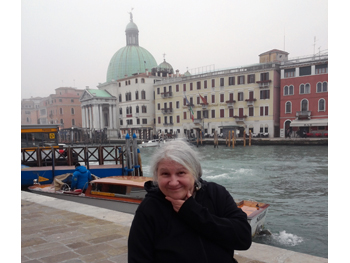
|
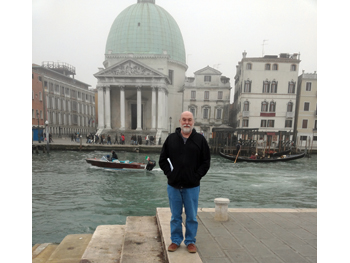
|
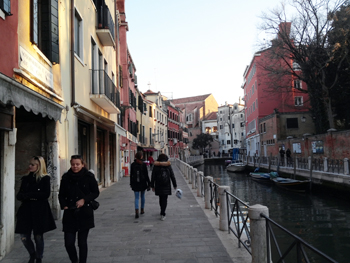
|
| We just arrived in Venice! | John with San Simeone Piccolo and Grand Canal in background | Near our Bed & Breakfast. |
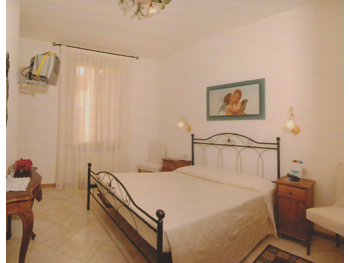
|
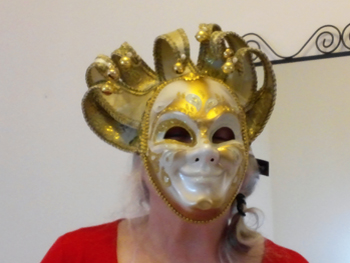
|
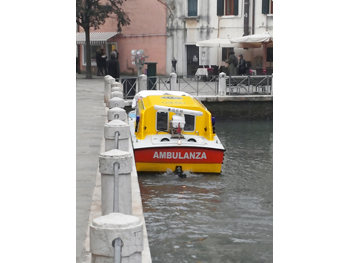
|
| Our home for two nights in Venice. | Ruth tries on her new mask. | Ambulance boat in Venice |
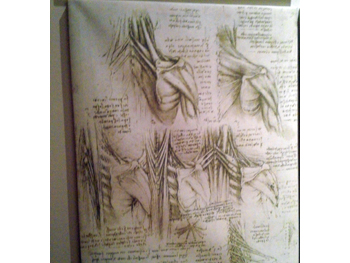
|
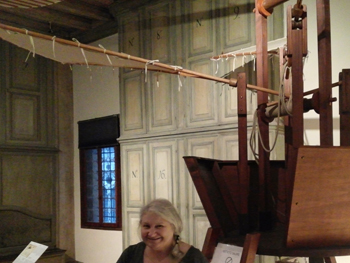
|
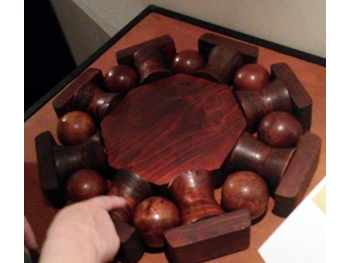
|
| Anatomy pages from Leonardo da Vinci's notebooks at the Leonardo da Vinci Museum | Ruth with the model of da Vinci's helicopter | da Vinci's ball bearings |
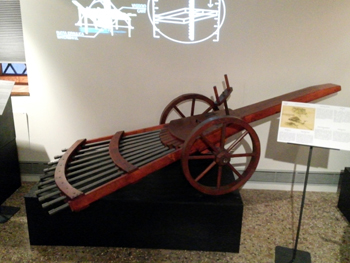
|
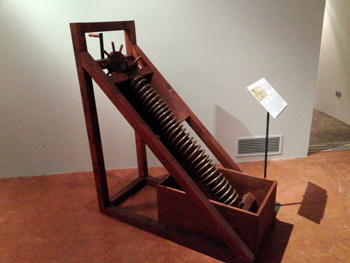
|
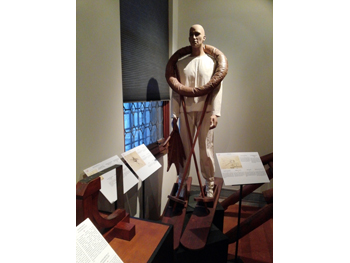
|
| da Vinci's multi-barreled gun | da Vinci's water pump | da Vinci's Scuba gear |
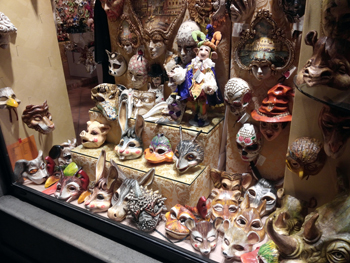
|
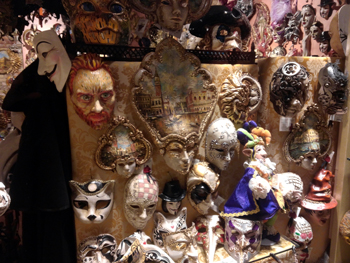
|
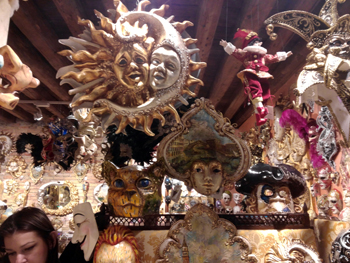
|
| There were many shops selling masks | Masks of every conceivable variety | Great window displays attracted customers |
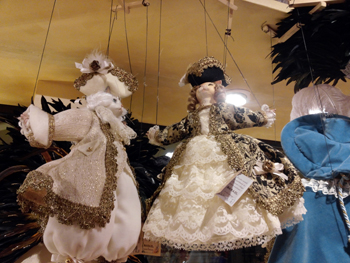
|
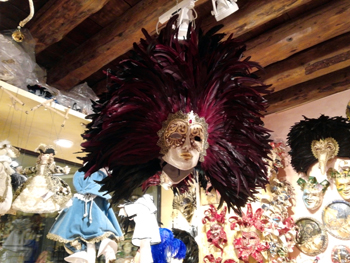
|
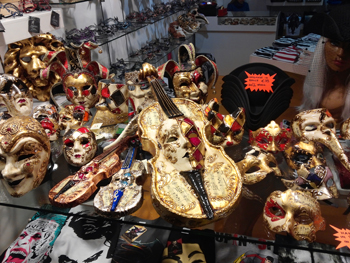
|
| This mask shop also had many marionettes | Many masks were adorned with feathers | We liked this violin mask |
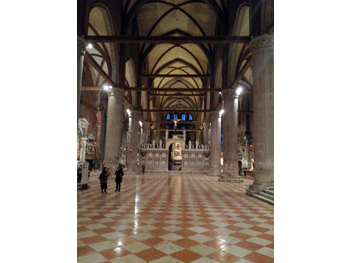
|
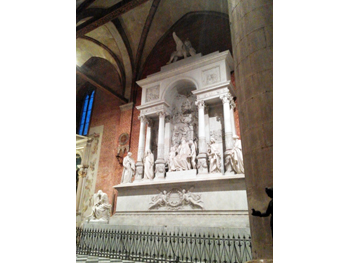
|
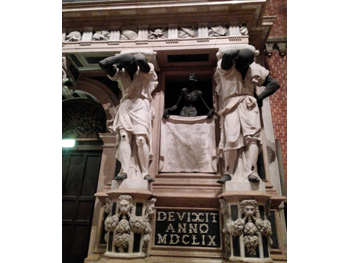
|
| Interior of Basilica di Santa Maria Gloriosa dei Frari completed in 1338. | Titian's grave in Basilica di Santa Maria Gloriosa dei Frari | Slaves and a skeleton on the tomb of Doge Giovanni Pesaro |
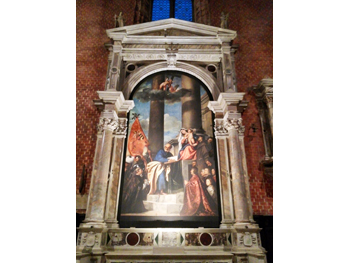
|
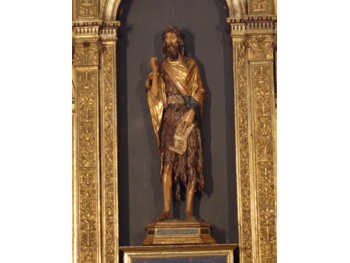
|
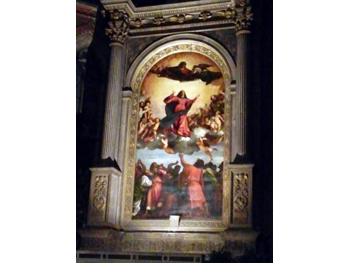
|
| Titian's Madonna of the Pesaro Family (1526) | St John the Baptist by Donatello (1438) | The Assumption of the Virgin by Titian (1518) |
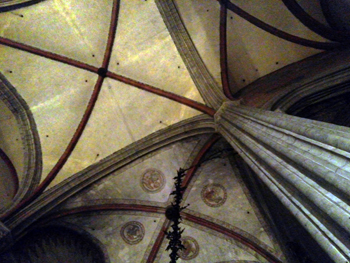
|
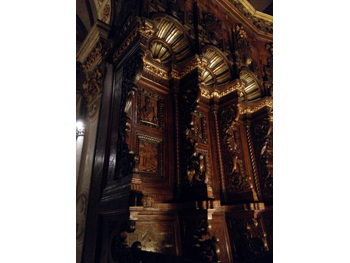
|
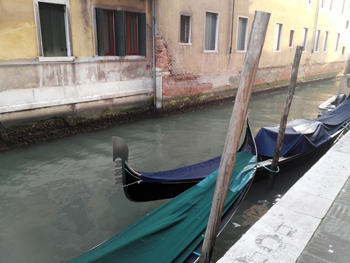
|
| Vaulted ceilings in Basilica di Santa Maria Gloriosa dei Frari (1338) | Detail of the choir stalls (1460s) | Gondola moored outside our B&B |
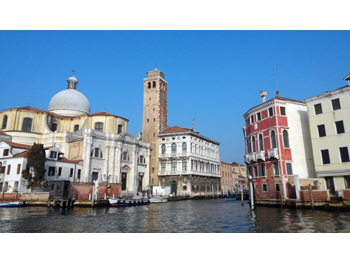
|
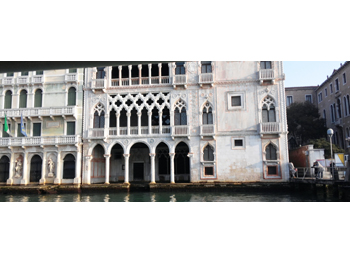
|
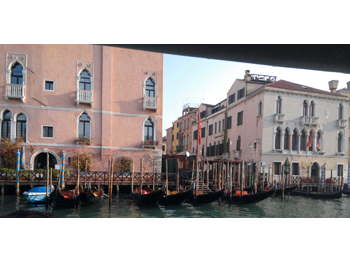
|
| At the start of our vaporetto (water bus) trip down the Grand Canal |
Ca 'd'Oro (Golden House) (1434) on the Grand Canal |
Gondola parking |
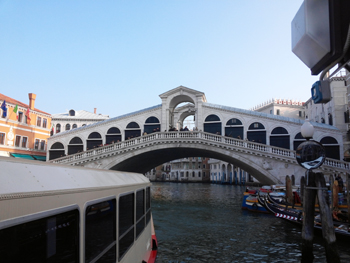
|
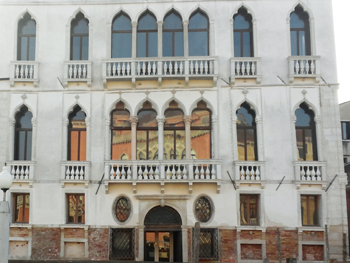
|
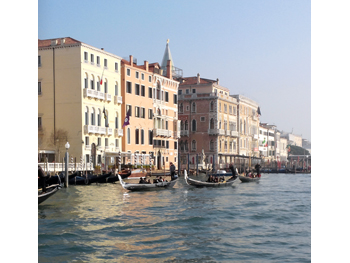
|
|
Rialto Bridge (1591). As late as the 19th century the only bridge in Venice. |
I liked the mixture of Eastern and Western influences on these windows. | A gaggle of gondolas |
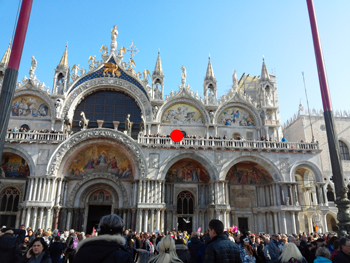
|
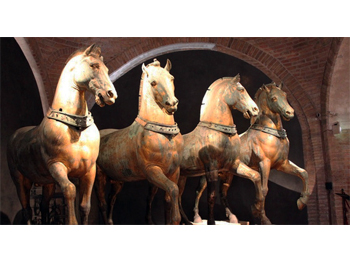
|
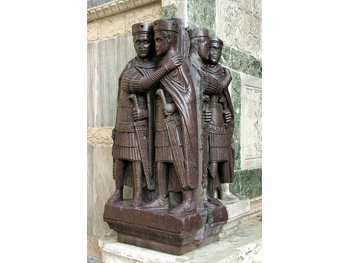
|
| St. Mark's Basilica. Ruth and I watched the parade and crowds on the balcony where the red circle is. | The four horses of St. Marks (fourth century BCE) | Portrait of the Four Tetrarchs (300 AD) |
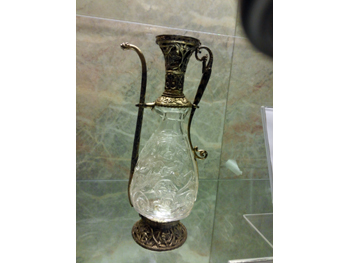
|
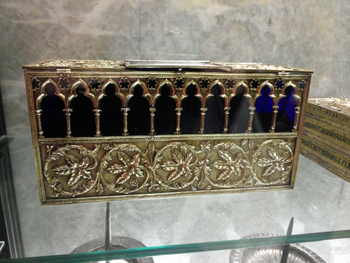
|
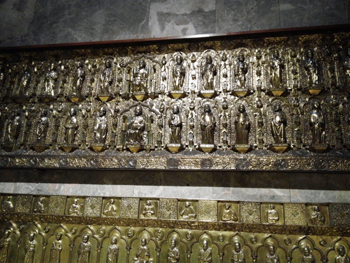
|
| In St. Mark's Basilica Treasury, a rock-crystal cruet (13th Century) | 13th Century small gold chest | Gold altar-facings from 13th and 15th centuries |
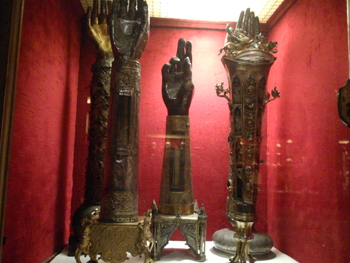
|
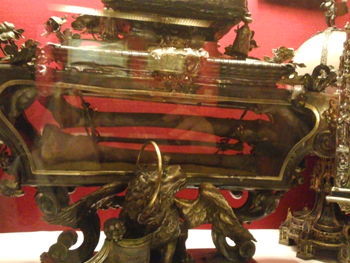
|
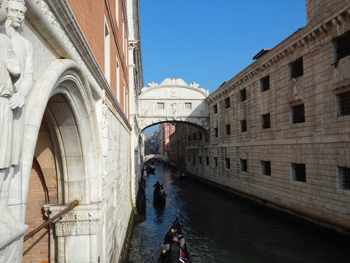
|
| Reliquary holding saints' relics stolen from the Byzantine Empire | Golden reliquary holding bones of Doge Orseolo (978 AD) | Bridge of Sighs |
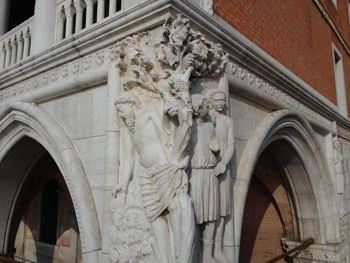
|
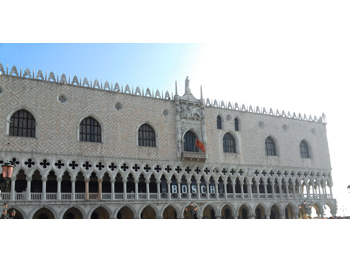
|
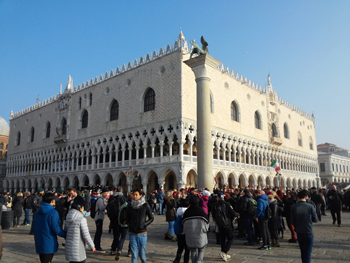
|
| 'Drunkenness of Noah' sculpture on the corner of the Doge's Palace | The Doge's Palace | The Doge's Palace |
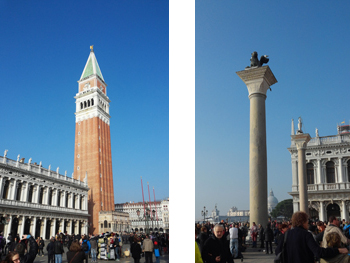
|
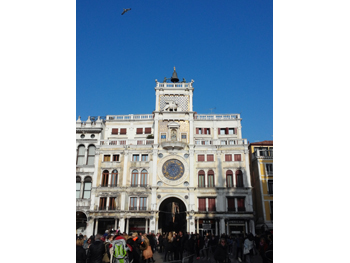
|
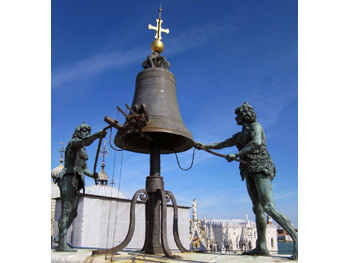
|
|
The bell tower and the columns of St. Mark's Square (1125) |
St Mark's clock tower | At the top of the tower, two metal men chime the hour by hammering on a bell (1496). |
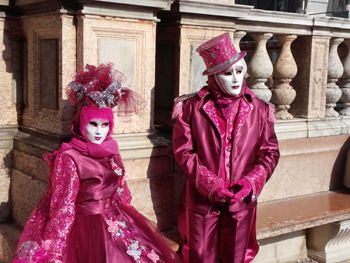
|
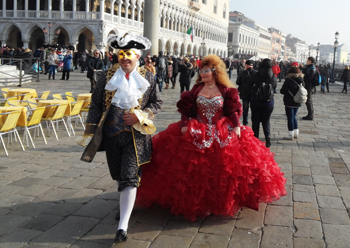
|
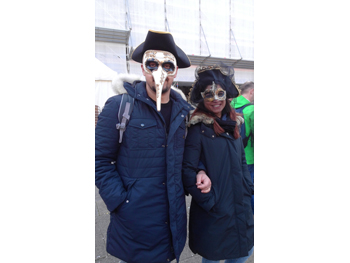
|
| People in Carnavale costumes wandered throughout St. Mark's Square | We wondered how much time they put into their costumes | Lots of tourists just bought and wore masks. |
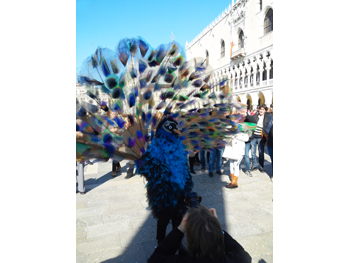
|
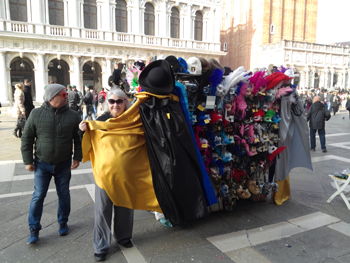
|
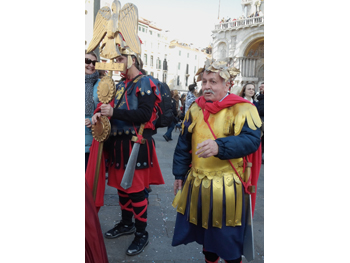
|
| This peacock was a favorite of the children. | Ooooh! I want it says Ruth. | Roman soldiers |
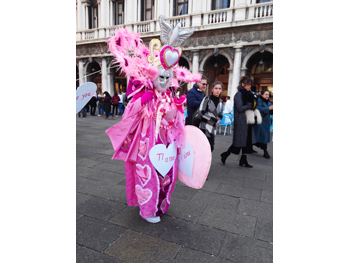
|
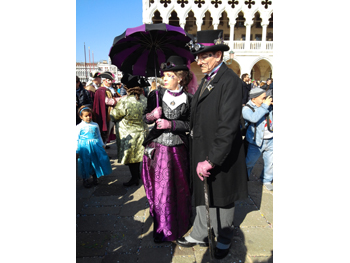
|
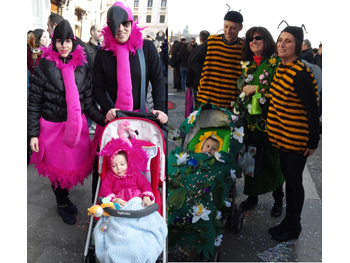
|
| Lots of hearts and love | We saw several Steampunk couples. | Families chose cute themes |
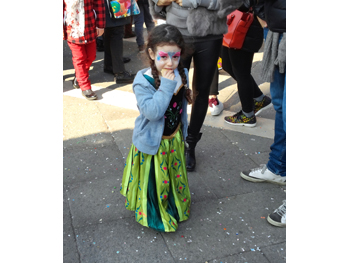
|
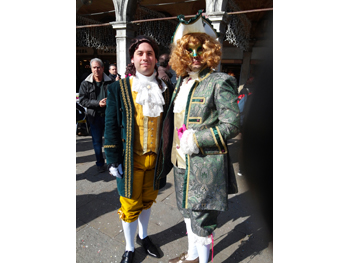
|
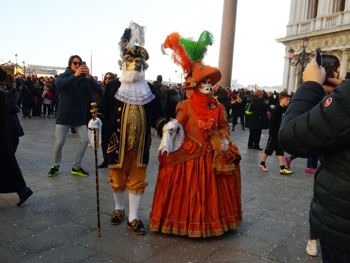
|
| Little girl enjoying a cookie | Not afraid to flaunt it | Regal couple |
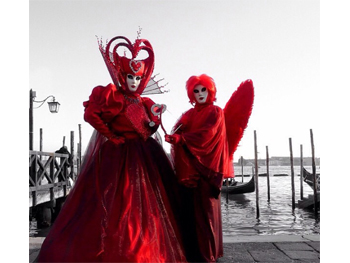
|
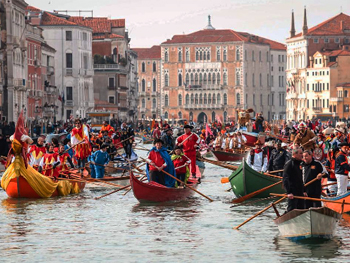
|
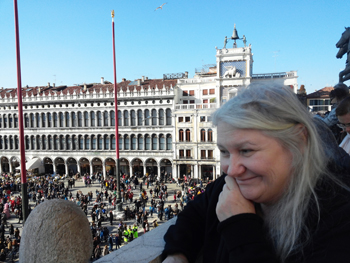
|
| Queen of Hearts | Grand Opening of the Venice Carnival | Ruth up on the balcony of St. Mark's Basilica |
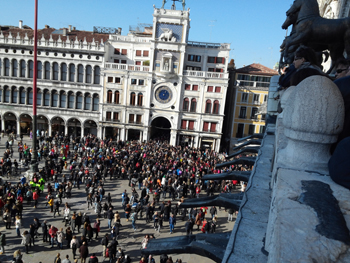
|
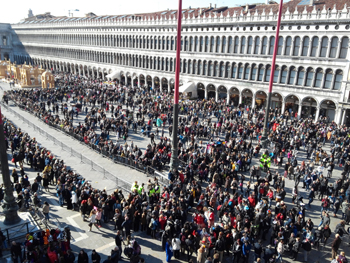
|
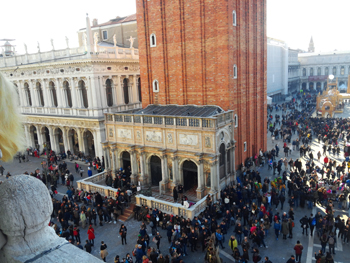
|
| The clock tower and Carnavale crowds | People gathering in San Marco Square for the Carnavale Parade | Base of the bell tower |
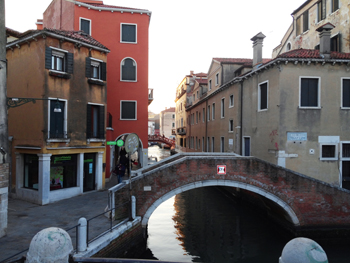
|
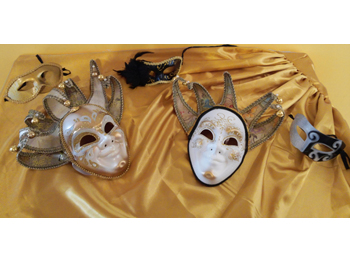
|
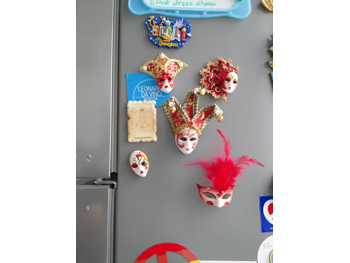
|
| Many small bridges connect the 117 islands that comprise Venice | Ruth's collection of masks from Venice | Back home in Nice, we added the Venice magnets to our collection. |